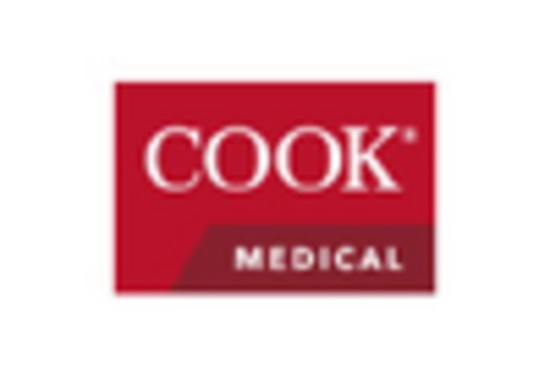Rising Incidence of Aneurysms
The increasing prevalence of abdominal aortic aneurysms (AAAs) is a primary driver for the Abdominal Stent Graft System Market. As populations age, the incidence of AAAs rises, necessitating effective treatment options. According to recent data, the global incidence of AAAs is estimated to be around 1.5 to 3% in individuals over 50 years of age. This demographic shift indicates a growing patient population requiring intervention, thereby propelling the demand for stent graft systems. Furthermore, advancements in imaging techniques have improved the detection rates of AAAs, leading to earlier interventions. Consequently, healthcare providers are increasingly adopting stent grafts as a preferred treatment modality, which is likely to enhance market growth in the coming years.
Increasing Healthcare Expenditure
Rising healthcare expenditure across various regions is contributing to the growth of the Abdominal Stent Graft System Market. As countries invest more in healthcare infrastructure and technologies, the availability of advanced medical devices, including stent grafts, increases. For instance, healthcare spending in several developed nations has seen a steady rise, with projections indicating a growth rate of around 5% annually. This increase in funding allows for better access to innovative treatments and technologies, thereby facilitating the adoption of stent graft systems. Moreover, as healthcare systems prioritize patient outcomes and cost-effectiveness, the demand for effective and efficient treatment options like stent grafts is likely to rise.
Regulatory Support and Approval Processes
The evolving regulatory landscape is playing a crucial role in shaping the Abdominal Stent Graft System Market. Regulatory bodies are increasingly focusing on streamlining approval processes for innovative medical devices, which can expedite the introduction of new stent graft technologies to the market. Recent initiatives aimed at enhancing patient safety and efficacy standards have led to more rigorous testing and validation protocols. However, these measures also ensure that only the most effective products reach the market, fostering consumer confidence. As regulatory support continues to evolve, it is expected to encourage investment in research and development, ultimately driving the growth of the abdominal stent graft market.
Technological Innovations in Stent Design
Technological advancements in stent graft design are significantly influencing the Abdominal Stent Graft System Market. Innovations such as the development of bioresorbable stents and improved materials have enhanced the performance and safety profiles of these devices. For instance, the introduction of drug-eluting stents has shown promise in reducing restenosis rates, which is a common complication associated with traditional stents. Additionally, the integration of advanced imaging technologies, such as 3D imaging and real-time monitoring, allows for more precise placement and better patient outcomes. As these technologies continue to evolve, they are expected to drive the adoption of stent graft systems, thereby expanding the market further.
Growing Preference for Minimally Invasive Procedures
The shift towards minimally invasive surgical techniques is a significant factor driving the Abdominal Stent Graft System Market. Patients and healthcare providers increasingly favor procedures that offer reduced recovery times, lower complication rates, and minimal scarring. Stent grafts, which can be deployed through small incisions, align with this trend, making them an attractive option for treating AAAs. Market data indicates that minimally invasive procedures are projected to grow at a compound annual growth rate (CAGR) of approximately 8% over the next five years. This growing preference is likely to enhance the demand for abdominal stent grafts, as they provide effective solutions while adhering to the principles of minimally invasive surgery.


















Leave a Comment